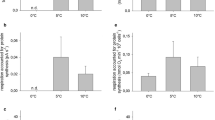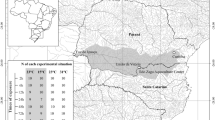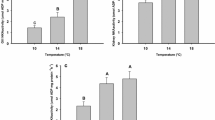Abstract
Oxygen demand elicited by the main cellular energy consumers was examined in isolated hepatocytes of sub-Antarctic (Lepidonotothen larseni) and high-Antarctic notothenioids (Trematomus eulepidotus, Trematomus pennellii, Trematomus lepidorhinus, Trematomus bernacchii, Artedidraco orianae) and in a zoarcid (Pachycara brachycephalum) fish with respect to the role of cellular metabolism in co-defining thermal tolerance. The relative proportions of energy allocated to protein and RNA/DNA synthesis, ion regulation and ATP synthesis were quantified between 0°C and 15°C by analysis of inhibitor sensitive cellular respiration. In all the investigated species, protein synthesis constituted 25–37%, RNA synthesis 24–35%, Na+/K+-ATPase 40–45% and mitochondrial ATP synthesis 57–65% of total respiration. The sub-Antarctic nototheniid L. larseni displayed lower cellular protein synthesis rates but somewhat higher active ion regulation activities than its high-Antarctic confamilials, as is typical for more eurythermal species. Assumed thermal optima were mirrored in minimized overall cellular energy demand. In the sub-Antarctic L. larseni and P. brachycephalum, minima of oxygen consumption were located between 3°C and 6°C, indicating elevated energy turnover below and above these temperatures. In contrast, the high-Antarctic species displayed progressively rising respiration rates during warming with a cellular energetic minimum at 0°C. The sub-Antarctic nototheniid and the zoarcid showed signs of cold-eurythermy and appear to live close to their lower limit of thermal tolerance, while high-Antarctic notothenioids show high degrees of energetic efficiency at 0°C. All cellular preparations maintained energy budgets over a wide thermal range, supporting the recent concept that thermal limits are set by oxygen and associated energy limitations at the whole organism level.



Similar content being viewed by others
References
Arntz WE, Brey T, Gallardo VA (1994) Antarctic zoobenthos. Oceanogr Mar Biol Ann Rev 32:241–304
Atkinson D (1977) Cellular energy metabolism and its regulation. Academic, New York, pp 218
Bock C, Sartoris FJ, Wittig RM, Pörtner HO (2001) Temperature-dependent pH regulation in stenothermal Antarctic and eurythermal temperate eelpout (Zoarcidae): an in-vivo NMR study. Polar Biol 24:869–874
Bradford MM (1976) A rapid and sensitive method for the quantitation of microgram quantities of protein utilizing the principle of protein-dye binding. Anal Biochem 72:248–254
Buttgereit F, Brand MD (1995) A hierarchy of ATP-consuming processes in mammalian cells. Biochem J 312:163–167
Casey TM, Pakay JL, Guppy M, Arthur PG (2002) Hypoxia causes downregulation of protein and RNA synthesis in noncontracting Mammalian cardiomyocytes. Circ Res 90:777–783
Clarke A and Johnston NM (1999) Scaling of metabolic rate with body mass and temperature in teleost fish. J Anim Ecol 68:893–905
Dȁ9Amico S, Claverie P, Collins T, Georlette D, Gratia E, Hoyoux A, Meuwis MA, Feller G, Gerday C (2002) Molecular basis of cold adaptation. Philos Trans R Soc Lond B Biol Sci 357:917–925
Detrich HW III (1997) Microtubule assembly in cold-adapted organisms: functional properties and structural adaptations of tubulins from antarctic fishes. Comp Biochem Physiol A Physiol 118:501–513
Di prisco G (2000) Life style and biochemical adaptation in antarctic Fishes. J Mar Syst 27:253–265
Eastman JT (1993) Antarctic fish biology: evolution in a unique environment. Academic, New York
Egginton S (1997a) Control of tissue blood flow at very low temperatures. J Therm Biol 22:403–407
Egginton S (1997b) A comparison of the response to induced exercise in red- and white-blooded Antarctic fishes. J Comp Physiol B 167:129–134
Farrell AP (1993) Cardiac output in fish: regulation and limitations. In: Bicudo JE (eds) The vertebrate gas transport cascade: adaptions to environmet and mode of life. CRC Press Inc., Boca Raton, pp 208–214
Farrell AP, Clutterham SM (2003) On-line venous oxygen tensions in rainbow trout during graded exercise at two acclimation temperatures. J Exp Biol 206:487
Gamper NL, Savina MV (2000) Reversible metabolic depression in hepatocytes of lamprey (Lampetra fluviatilis) during pre-spawning: regulation by substrate availability. Comp Biochem Physiol B 127:147–154
Gon O and Heemstra P (1990) Fishes of the Southern Ocean. J.L.B. Smith Institute for Ichthyology, Grahamstown, South Africa
Hardewig I, Peck LS, Pörtner HO (1999) Thermal sensitivity of mitochondrial function in the Antarctic Notothenioid Lepidonotothen Nudifrons. J Comp Physiol B 169:597–604
Haschemeyer AEV and Mathews RW (1982) Effects of temperature extremes on protein synthesis in liver of toadfish, Opsanus tau, in vivo. Biol Bull Mar Biol Lab, Woods Hole 162:18–27
Heath AG and Hughes GM (1973) Cardiovascular and respiratory changes during heat stress in rainbow trout (Salmo gairdneri). J Exp Biol 59:323–38
Johnston IA, Calvo J, Guderley H, Fernandez D, Palmer L (1998) Latitudinal variation in the abundance and oxidative capacities of muscle Mitochondria in Perciform fishes. J Exp Biol 201:1–12
Kock KH (1992) Antarctic fish and fisheries. Cambridge University Press, Cambridge, UK
Krumschnabel G, Malle S, Schwarzbaum PJ, Wieser W (1994a) Glycolytic function in goldfish hepatocytes at different temperatures—relevance for Na+ pump activity and protein-synthesis. J Exp Biol 192:285–290
Krumschnabel G, Schwarzbaum PJ, Wieser W (1994b) Coupling of energy supply and energy demand in isolated goldfish Hepatocytes. Physiol Zool 67:438–448
Krumschnabel G, Biasi C, Schwarzbaum PJ, Wieser W (1997) Acute and chronic effects of temperature, and of nutritional state, on ion homeostasis and energy metabolism in teleost hepatocytes. J Comp Physiol B 167:280–286
Krumschnabel G, Manzl C, Schwarzbaum PJ (2001) Importance of glycolysis for the energetics of anoxia-tolerant and anoxia-intolerant teleost hepatocytes. Physiol Biochem Zool 74:413–419
Langenbuch M and Pörtner HO (2003) Energy budget of hepatocytes from Antarctic fish (Pachycara brachycephalum and Lepidonotothen kempi) as a function of ambient CO2: pH-dependent limitations of cellular protein biosynthesis? J Exp Biol 206:3895–3903
Lannig G, Bock C, Sartoris FJ, Pörtner HO (2004) Oxygen limitation of thermal tolerance in cod, Gadus morhua L., studied by magnetic resonance imaging and on-line venous oxygen monitoring. Am J Physiol Regul Integr Comp Physiol 287:R902–R910
Lucassen M, Schmidt A, Eckerle LG, Pörtner HO (2003) Mitochondrial proliferation in the permanent vs. temporary cold: enzyme activities and mRNA levels in Antarctic and temperate zoarcid fish. Am J Physiol Regul Integr Comp Physiol 285:R1410–R1420
Mark FC, Bock C, Pörtner HO (2002) Oxygen-limited thermal tolerance in Antarctic fish investigated by MRI and 31P-MRS. Am J Physiol 283:R1254–R1262
Marsh AG, Maxson REJ, Manahan DT (2001) High macromolecular synthesis with low metabolic cost in Antarctic sea urchin embryos. Science 291:1950–1952
Mommsen TP, Moon TW, Walsh PJ (1994) Hepatocytes: isolation, maintenance and utilization. In: Hochachka PW, Mommsen TP (eds) Biochemistry and molecular biology of fishes, analytical techniques, vol. 3. chapter 30, Elsevier Science, Amsterdam, pp 355–372
Pannevis MC, Houlihan DF (1992) The energetic cost of protein-synthesis in isolated hepatocytes of rainbow-trout (Oncorhynchus-Mykiss). J Comp Physiol B 162:393–400
Pörtner HO and Sartoris FJ (1999) Invasive studies of intracellular acid-base parameters: quantitative analyses during environmental and functional stress. In: Taylor EW, Egginton S, Raven JA (eds) Regulation of tissue pH in plants and animals: a reappraisal of current techniques. SEB Seminar Series. Cambridge University Press, Cambridge England, pp 69–98
Pörtner HO (2001) Climate change and temperature-dependent biogeography: oxygen limitation of thermal tolerance in animals. Naturwissenschaften 88:137–146
Pörtner HO (2002) Climate variations and the physiological basis of temperature dependent biogeography: systemic to molecular hierarchy of thermal tolerance in animals. Comp Biochem Physiol A Mol Integr Physiol 132:739–761
Pörtner HO, Mark FC, Bock C (2004) Oxygen limited thermal tolerance in fish? Answers obtained by nuclear magnetic resonance techniques. Respir Physiol Neurobiol 141:243–260
Pörtner HO, Lucassen M, Storch D (2005) Metabolic biochemistry, thermal tolerance and the capacities of physiological and ecological function: an integrative view. Fish Physiol 22 (in press)
Sartoris FJ, Bock C, Pörtner HO (2003a) Temperature-dependent pH regulation in eurythermal and stenothermal marine fish: an interspecies comparison using 31P-NMR. J Therm Biol 28:363–371
Sartoris FJ, Bock C, Serendero I, Lannig G, Pörtner HO (2003b) Temperature dependent changes in energy metabolism, intracellular pH and blood oxygen tension in the Atlantic cod. J Fish Biol 62:1239–1253
Smith MAK and Haschemeyer AEV (1980) Protein metabolism and cold adaptation in Antarctic fishes. Physiol Zool 53:373–382
Smith RW, Houlihan DF (1995) Protein-synthesis and oxygen-consumption in fish cells. J Comp Physiol B 165:93–101
Smith RW, Blaney SC, Dowling K, Sturm A, Jonsson M, Houlihan DF (2001) Protein synthesis costs could account for the tissue-specific effects of sub-lethal copper on protein synthesis in rainbow trout (Oncorhynchus Mykiss). Aquat Toxicol 53:265–277
Somero GN, DeVries AL (1967) Temperature tolerance of some Antarctic fishes. Science 156:257–258
Storch D, Lannig G, Pörtner H (2005) Temperature dependent protein synthesis capacities in Antarctic and temperate (North Sea) fish (Zoarcidae). J Exp Biol 208:2409–2420
Taylor CR and Weibel ER (1981) Design of the mammalian respiratory system. I: problem and strategy. Respir Physiol 44:1–10
Van Dijk PLM, Hardewig I, Tesch C, Pörtner HO (1999) Physiological disturbances at critically high temperatures: a comparison between stenothermal Antarctic, and eurythermal temperate eelpouts (Zoarcidae). J Exp Biol 202:3611–3621
Wieser W and Krumschnabel G (2001) Hierarchies of ATP-consuming processes: direct compared to indirect measurements, and comparative aspects. Biochem J 355:389–395
Acknowledgements
The authors would like to thank E-M. Brodte, K. Mintenbeck, N. Koschnick, C. Bock, R. Knust and the crew of RV Polarstern cruise ANT XXI-2 for their valuable and excellent help in catch, identification, maintenance and preparation of the fish species used in this study, and T. Brey for his helpful comments on the statistics.
Author information
Authors and Affiliations
Corresponding author
Rights and permissions
About this article
Cite this article
Mark, F.C., Hirse, T. & Pörtner, H.O. Thermal sensitivity of cellular energy budgets in some Antarctic fish hepatocytes. Polar Biol 28, 805–814 (2005). https://doi.org/10.1007/s00300-005-0018-0
Received:
Revised:
Accepted:
Published:
Issue Date:
DOI: https://doi.org/10.1007/s00300-005-0018-0




